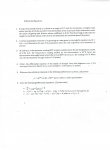Differential Equations
1. A long, very smooth board is inclined at an angle of 15 degrees with the horizontal. A weight starts with a velocity of 0.3 feet per second and 10 feet from the bottom of the board, and slides downward under the action of gravity and friction whose coefficient is 0.12. Find how long it will take the weight to reach the bottom of the board, and determine the terminal speed.
2. A certain population is known to be growing at a rate given by the logistic equation dx/dt = x (b - ax). Determine the size of the population when the rate of growth is at a maximum.
3. At 2:00pm, a thermometer reading 80 degrees Fahrenheit is taken outside where the air temperature is 20 degrees Fahrenheit. At 2:03pm, the temperature reading yielded by the thermometer is 42 degrees Fahrenheit. Later, the thermometer is brought inside where the air is at 80 degrees Fahrenheit. At 2:10pm, the reading is 71 degrees Fahrenheit. When was the thermometer brought indoors?
4. Obtain the differential equation of the family of straight lines with algebraic sum of the intercepts fixed at k. Sketch three representatives of the family.
5. Eliminate the arbitrary constants in the following differential equation:
. . . . .\(\displaystyle y\, =\, A\,e^{ax}\, \cos(bx)\, +\, B\,e^{ax}\, \sin(bx),\, \mbox{ where }\, a\, \mbox{ and }\, b\, \mbox{ are parameters.}\)
6. Solve the following differential equations:
. . .\(\displaystyle \mbox{a. }\, \dfrac{dy}{dx}\, +\, \dfrac{1}{y\,\sin^{-1}\, y\, (x^3\, +\, 1)}\, =\, 0\)
. . .\(\displaystyle \mbox{b. }\, y\, (2x^2\, -\, xy\, +\, y^2)\, dx\, -\, x^2\, (2x\, -\, y)\, dy\, =\, 0,\)
. . . . .\(\displaystyle \mbox{with the curve passing through }\, (1,\, 2)\)
. . .\(\displaystyle \mbox{c. }\, (1\, -\, xy)^{-2}\, dx\, +\, \left(y^2\, +\, x^2\, (1\, -\, xy)^{-2}\right)\, dy\, =\, 0,\)
. . . . .\(\displaystyle \mbox{where, when }\, x\, =\, 2,\, \mbox{ then }\, y\, =\, 1.\)
1. A long, very smooth board is inclined at an angle of 15 degrees with the horizontal. A weight starts with a velocity of 0.3 feet per second and 10 feet from the bottom of the board, and slides downward under the action of gravity and friction whose coefficient is 0.12. Find how long it will take the weight to reach the bottom of the board, and determine the terminal speed.
2. A certain population is known to be growing at a rate given by the logistic equation dx/dt = x (b - ax). Determine the size of the population when the rate of growth is at a maximum.
3. At 2:00pm, a thermometer reading 80 degrees Fahrenheit is taken outside where the air temperature is 20 degrees Fahrenheit. At 2:03pm, the temperature reading yielded by the thermometer is 42 degrees Fahrenheit. Later, the thermometer is brought inside where the air is at 80 degrees Fahrenheit. At 2:10pm, the reading is 71 degrees Fahrenheit. When was the thermometer brought indoors?
4. Obtain the differential equation of the family of straight lines with algebraic sum of the intercepts fixed at k. Sketch three representatives of the family.
5. Eliminate the arbitrary constants in the following differential equation:
. . . . .\(\displaystyle y\, =\, A\,e^{ax}\, \cos(bx)\, +\, B\,e^{ax}\, \sin(bx),\, \mbox{ where }\, a\, \mbox{ and }\, b\, \mbox{ are parameters.}\)
6. Solve the following differential equations:
. . .\(\displaystyle \mbox{a. }\, \dfrac{dy}{dx}\, +\, \dfrac{1}{y\,\sin^{-1}\, y\, (x^3\, +\, 1)}\, =\, 0\)
. . .\(\displaystyle \mbox{b. }\, y\, (2x^2\, -\, xy\, +\, y^2)\, dx\, -\, x^2\, (2x\, -\, y)\, dy\, =\, 0,\)
. . . . .\(\displaystyle \mbox{with the curve passing through }\, (1,\, 2)\)
. . .\(\displaystyle \mbox{c. }\, (1\, -\, xy)^{-2}\, dx\, +\, \left(y^2\, +\, x^2\, (1\, -\, xy)^{-2}\right)\, dy\, =\, 0,\)
. . . . .\(\displaystyle \mbox{where, when }\, x\, =\, 2,\, \mbox{ then }\, y\, =\, 1.\)
Attachments
Last edited by a moderator:

